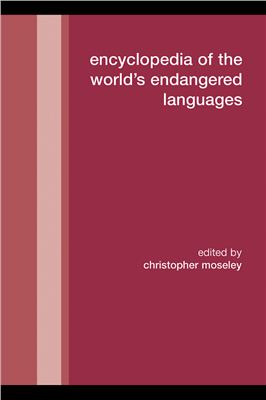Pages: 688
Publisher: Routledge (2007)
Quality: good: pdf
It can be said that most of the world's languages are endangered, because an estimated 96 percent of them are spoken by only 4 percent of the world's population. They are disappearing as the small groups of speakers are absorbed into larger cultures or die out without the children leaing the language. This volume is an effort to briefly describe the status of the many languages that are in danger of disappearing within the first half of the twenty-first century. The degree of peril assigned to a language is based on whether or not the language is taught, the age of the youngest fluent speakers, and the total number of speakers. Languages that are just remembered as having been spoken are characterized as extinct. While Ethnologue: Languages of the World (SIL Inteational, 2005) provides a country-by-country summary of all living languages and relies heavily on tables and maps, this volume is more conceed with linguistic families and is primarily narrative in form. Information is presented in large continental or regional groupings. The introductory essays for each large geographic area are excellent at providing historic overviews, descriptions of language families in the area, national issues, and some recommendations. Individual languages are arranged alphabetically, and entries for each language provide affiliation, demographic data, endangerment status, and threats. The text is accompanied by around 20 maps showing general regions and where endangered languages are concentrated. An "Index of Languages" completes the work. A library serving anthropologists, linguists, and historians will find that Encyclopedia of the World's Endangered Languages and Ethnologue complement one another, and those libraries that can afford them will want both. The Encyclopedia of the World's Endangered Languages is expensive but a valuable resource in academic and large public libraries.
ISBN13: 978-0-7007-1197-0 (Print Edition)
ISBN 0-203-64565-0 Master e-book ISBN
Publisher: Routledge (2007)
Quality: good: pdf
It can be said that most of the world's languages are endangered, because an estimated 96 percent of them are spoken by only 4 percent of the world's population. They are disappearing as the small groups of speakers are absorbed into larger cultures or die out without the children leaing the language. This volume is an effort to briefly describe the status of the many languages that are in danger of disappearing within the first half of the twenty-first century. The degree of peril assigned to a language is based on whether or not the language is taught, the age of the youngest fluent speakers, and the total number of speakers. Languages that are just remembered as having been spoken are characterized as extinct. While Ethnologue: Languages of the World (SIL Inteational, 2005) provides a country-by-country summary of all living languages and relies heavily on tables and maps, this volume is more conceed with linguistic families and is primarily narrative in form. Information is presented in large continental or regional groupings. The introductory essays for each large geographic area are excellent at providing historic overviews, descriptions of language families in the area, national issues, and some recommendations. Individual languages are arranged alphabetically, and entries for each language provide affiliation, demographic data, endangerment status, and threats. The text is accompanied by around 20 maps showing general regions and where endangered languages are concentrated. An "Index of Languages" completes the work. A library serving anthropologists, linguists, and historians will find that Encyclopedia of the World's Endangered Languages and Ethnologue complement one another, and those libraries that can afford them will want both. The Encyclopedia of the World's Endangered Languages is expensive but a valuable resource in academic and large public libraries.
ISBN13: 978-0-7007-1197-0 (Print Edition)
ISBN 0-203-64565-0 Master e-book ISBN

